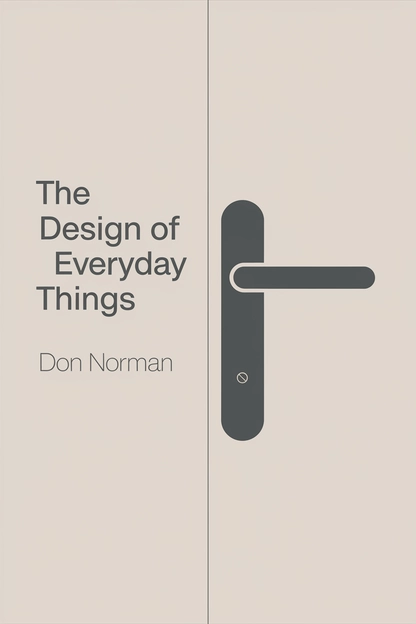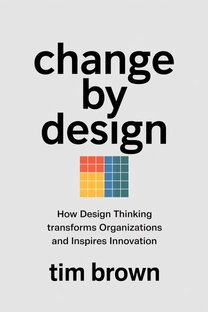
The Design of Everyday Things
by Don Norman
Brief overview
This book explores how seemingly ordinary objects can frustrate us when their design fails to consider human needs. By examining everyday items and technologies, it highlights how simple changes in design can dramatically improve usability, reduce errors, and create more satisfying experiences. Expect to learn the reasons behind bad design and how powerful, human-centered solutions can transform our interactions with the world.
Introduction
Have you ever struggled with a door that said “Pull” but you pushed anyway? That kind of confusion happens more often than it should. The book opens by pointing out these everyday design flaws, showing that they’re not our fault—they’re rooted in neglectful design that ignores human needs.
From desks covered in Post-it notes to complicated washing machines, we all grapple with objects that seem oddly tricky. This introduction sets the stage by suggesting that better design can remove the blame people place on themselves and put responsibility back on the object’s layout and instructions.
You’ll discover how everyday frustrations—like toggling the wrong stove burner or mixing up hot and cold taps—are symptoms of poorly implemented design principles. By highlighting these shared annoyances, the book motivates us to imagine a world where usability takes center stage.
Why Communication Matters
A recurring theme is that all design is about communication. A door handle that clearly shows you should push, or a faucet that’s obviously twistable, conveys its purpose without a word. The more effortlessly an object “talks” to you, the more likely you’ll use it correctly.
Here, the text introduces the idea of signifiers—the clues in our environment guiding our actions. It could be a graphical arrow on a screen or a textured surface on a handle. Signifiers are crucial because they subtly instruct us on what’s possible, making tasks simpler and more intuitive.
Conversely, when signifiers are missing or misleading, confusion reigns. We might push a door marked “Pull” or wonder why a control panel has unmarked switches. This mismatch often makes us blame ourselves, when all along, it’s a sign the design has failed to communicate properly.
What is The Design of Everyday Things about?
Don Norman’s “The Design of Everyday Things” explores how small design details can shape our daily experiences. From tricky doors to puzzling interfaces, each example illustrates that many user frustrations stem from products that fail to consider human psychology. By grounding design in real behaviors, this book shows why objects should guide us naturally, rather than leaving us confused.
It matters because it redefines our perception of ordinary tools, revealing how subtle changes to signifiers and constraints can make technology more intuitive. With Norman’s human-centered approach, readers learn to see both the visible and invisible elements that create satisfying, error-proof interactions in everything from digital devices to home appliances.
Review of The Design of Everyday Things
This title excels in its clear focus on usability and the way it ties everyday annoyances to deeper design principles. Norman’s explanation of feedback loops and physical constraints gives practical insights that anyone can apply, whether tweaking a machine interface or planning a website layout. These concepts prove that small adjustments can prevent big user mistakes, saving time and reducing stress.
Throughout the pages, the conversational tone makes complex ideas feel accessible. Real-world examples—like mislabeled doors or confusing stove knobs—lighten the theory, making it easy to understand why products fail us and how to fix them. This readability means both design professionals and casual readers can benefit from new perspectives on user-friendly solutions.
Ultimately, “The Design of Everyday Things” is worth your reading time if you want concrete methods to make gadgets, apps, or simple household items more intuitive. It’s a thorough guide that helps you spot design flaws and turn them into smarter, more satisfying user experiences.
Who should read The Design of Everyday Things?
- Product designers who need to improve usability and reduce errors
- UX professionals seeking human-centered design strategies
- Project managers looking for insights on how design choices affect user satisfaction
- Tech enthusiasts interested in making everyday devices more intuitive
- Entrepreneurs aiming to create accessible products from the ground up
About the author
Book summaries like The Design of Everyday Things
Why readers love Mindleap
10-Minute Book Insights
Get the core ideas from the world's best books in just 10 minutes of reading or listening.
Curated For You
Discover your next favorite book with personalized recommendations based on your interests.
AI Book ExpertNew
Chat with our AI to help find the best book for you and your goals.
Reviews of MindLeap
Love how I can get the key ideas from books in just 15 minutes! Perfect for my busy schedule and helps me decide which books to read in full.
Alex R.
The summaries are incredibly well-written and the audio feature is perfect for my commute. Such a time-saver!
Jessica M.
Great app for personal growth. The insights are clear and actionable, and I love how they capture the essence of each book.
Chris P.
The app is beautifully designed and the summaries are top-notch. Definitely worth every penny!
Sarah K.


